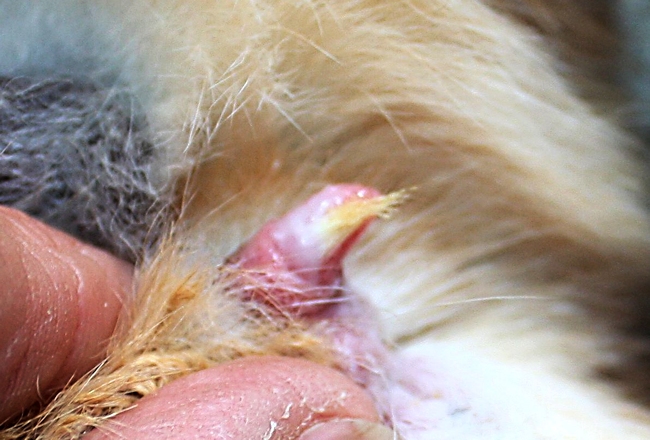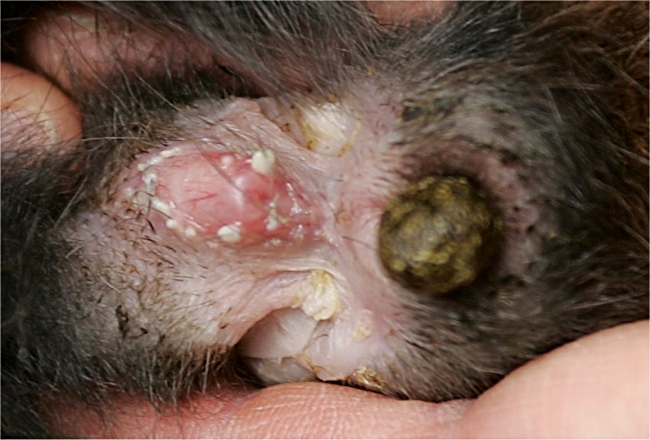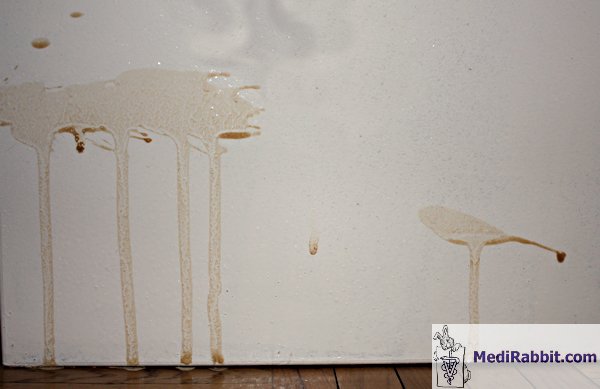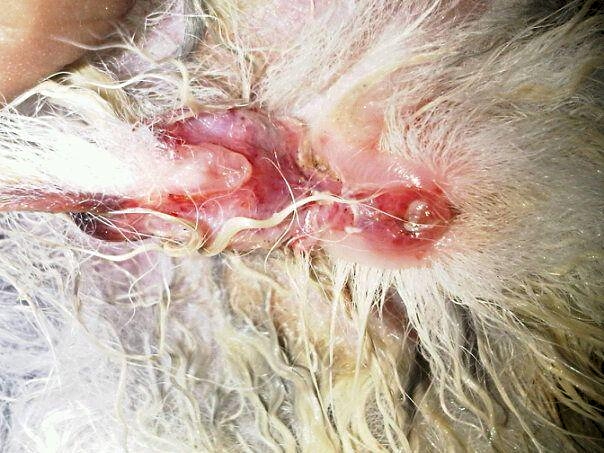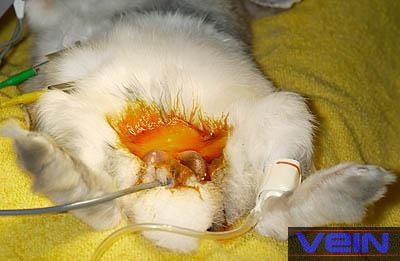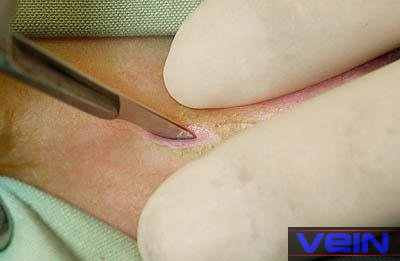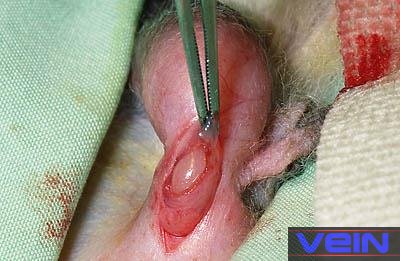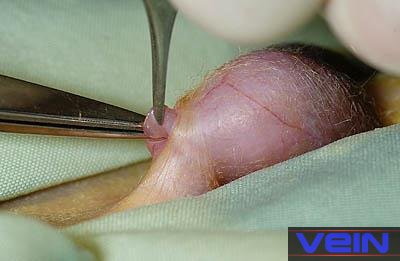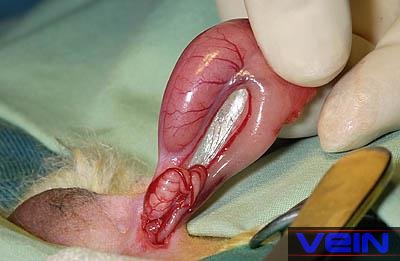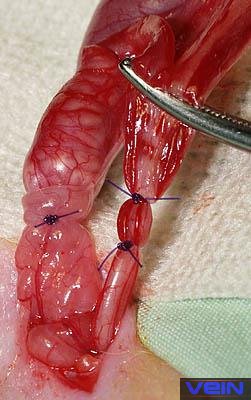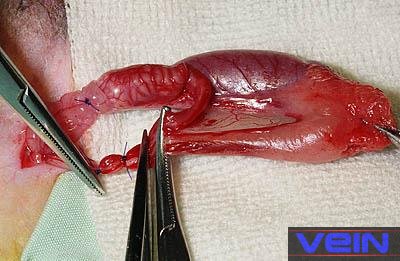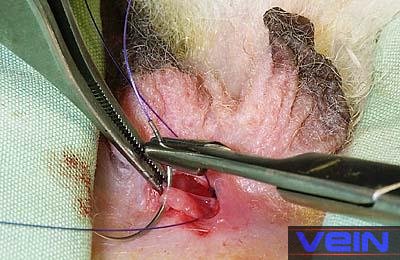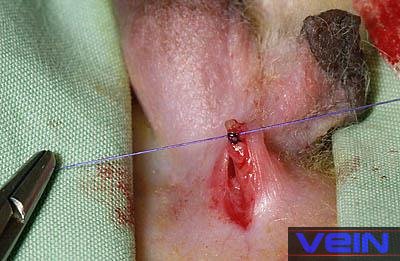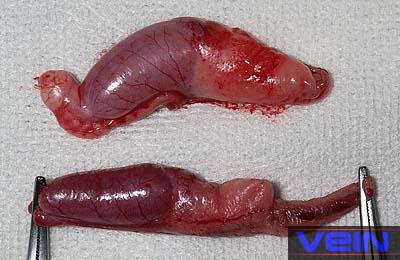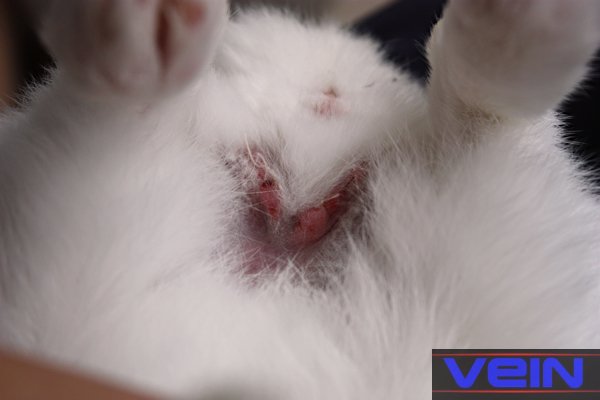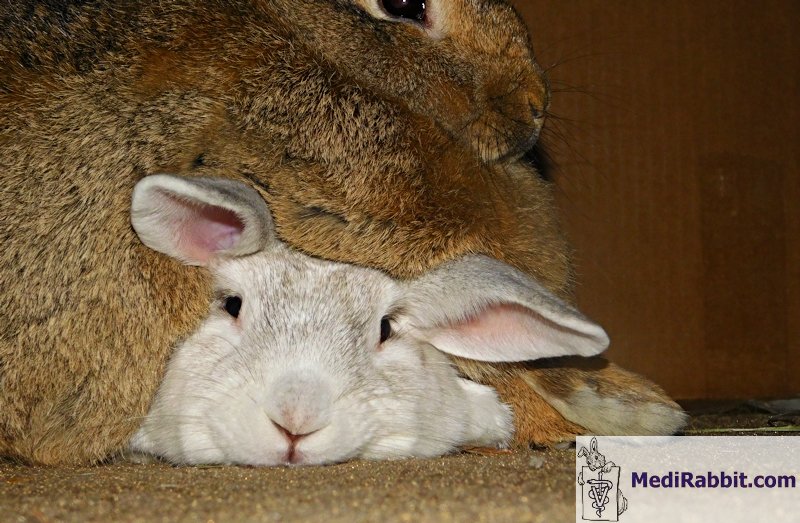Male
reproductive tract and orchidectomy
(castration
surgery)
Esther van Praag, Ph.D.
|
MediRabbit.com is
funded solely by the generosity of donors. Every
donation, no matter what the size, is appreciated and will aid in the
continuing research of medical care and health of rabbits. Thank you |
Warning: this file contains pictures that
may be disturbing for some persons.
|
The reproductive
organs of the male rabbit are very similar to that of other mammals, except
for the additional ability to retract the testis in the abdomen. They are
formed during the embryonic phase. They derive from primitive ancestors of
the kidney tubules and the ducts, except for the lobules of the testes and
the vasa recta. The blood vessels of the kidney will furthermore be used and
deviated in order to supply the testes and the scrotal wall with blood.
The reproductive organ of the male rabbit is composed of different
structures. One of them are the testes, which is composed of various
components: • Scrotal
sacs: they are located in the inguinal area, ventrally to the anus and can be
compared to a sac surrounded by skin and composed of muscles or connective
tissue. They contain the testes. • Testes:
they are the reproductive gland, which is composed of tubular loops, lobules
and a central tubular plexus (vasa
recta). The tubular lobules are lined with cells that develop the sperm,
through a process of cell divisions (meiosis) and maturation. The sperm is
brought to the tubular plexus (vasa
recta). The later structure is furthermore lined with endocrine cells,
secreting testosterone. • epididymis:
this is a coiled tube located at the surface of the testes The testes descent into the scrotum at the age of 2,5-3 months, and
castration surgery is usually done at the age of 4 or 5 months. Male rabbits
possess a life-long ability to move freely their testis between the scrotum
and the abdomen, via the inguinal ring. The response occurs during handling
and examination, or during a fight between 2 males. Indeed, entire male
rabbits will inevitably fight and attempt to “neuter” the other male by biting
in the scrotal region
Sebaceous (fat) glands surround the external genital parts of female and male rabbits. They are often not visible, except when full with a white fatty secretion. Here in a 5 year old castrated rabbit. Why castrate a male rabbit and when ?The castration of
male rabbits is recommended in order to reduce difficult behavior, like the
marking of its territory with strong smelling urine, aggressive attitude and
mounting of objects or human body parts like feet and arms.
Further medical reasons to favor the castration surgery include: • chronic difficult to treat
orchitis or epididymitis • neoplasia of the testes,
though this is rare in rabbits. Castration of male rabbits is done only after the testes have
descended into the scrotal sacs or little after. This happens around the age
of 3 months. Young males can, thus be castrated anytime between 3 to 6 months
of age. Dwarfs have usually a rapid development and can be castrated at the
age of 3 months or little after. Some veterinarian want, indeed, to wait one
or two weeks after the descent. Middle sized rabbits can be castrated after
the descent of testis, between 3 and 4 months of age, depending on the breed.
Bigger sized rabbits have a slower development and castration is usually done
between 4 and 6 months of age. If a male rabbit is not castrated shortly after the descent of the
testis into the scrotal sac, sexual behavior, spraying the environment with
urine and/or mounting feet and arms or aggression may become a settled
behavior. The secretion of testosterone will also lead to the development of
a typical strong body structure with a heavier head. Once neutered, these
males may calm down. Some do, however, continue to spray and mount/aggress
their rabbit companion. Orchidectomy is done under general anesthesia. It is a surgical
procedure that requires sterile surgical instruments and a preparation of the
skin, in order to minimize infection. Various surgical approaches are available for orchidectomy in rabbits,
described in books, videos, or scientific articles. The following pictorial
orchidectomy has been done according to the exterior extraction of the testis
technique. Pictorial castration surgical procedure
Post-surgical careThe administration of pain medication for at
least 24 h. after the surgery is highly recommended. Pain indeed induces
hormonal and physiological responses, which slow down the activity of the
digestive tract, delay food intake and recovery. The presence of blood in the urine during 24
to 48 h post-surgery is normal. Sometimes, the scrotum is filled with blood
and hemorrhaged. In rare cases, blood is observed to leak through the
sutures. Bleeders, small blood vessels that cannot be ligated, cause this
bleeding. It is a non-dangerous nuisance that can last a few days. The
administration of vitamin K can help accelerate clotting, if the bleeding is
still present after a few days. If the male rabbit was
adult and fertile, he should be confined for 7 to 10 days, and kept separated
from non-spayed females at least 4 weeks post-surgery. While sperma does not
survive long in the male reproductive system after the castration surgery,
the level of testosterone hormone take much longer to decrease in the blood.
This is why male behavior may continue a few weeks after castration. The
neutered rabbit is, however, no more able to fertilize a female rabbit. Younger non mature males
can be left with the female partner after a week already. With time, a strong bond
develops between rabbits that have been castrated.
Karan Nixon Wendy "squashing" Binky Bear, or
ultimate love between two bonded rabbits. AcknowledgementMany thanks to
Akira Yamanouchi (Veterinary
Exotic Information Network, Japan) and to Karan Nixon
for the permission to use their pictures to illustrate this page. Many thanks also
to Wendy, BB and Zippy rabbits, for their collaboration. Further InformationGilsanz V, Roe TF, Gibbens DT, Schulz EE, Carlson
ME, Gonzalez O, Boechat MI. Effect of sex steroids on peak bone density of
growing rabbits. Am J Physiol. 1988; 255(4 Pt 1):E416-21. Hussein SA, Azab ME,
Abdel-Maksoud H. Metabolic changes concerning the effect
of castration on some blood constituents in male rabbits. Dtsch
Tierarztl Wochenschr. 1999; 106(3):113-8. Jenkins JR. Surgical sterilization in small mammals.
Spay and castration. Veterinary Clin North
Am Exot Anim Pract. 2000; 3(3):617-27, v. Review. Millis DL, Walshaw R.
Elective castrationsd and ovariohysterectomies in
pet rabbits. J. Am. Anim Hosp. Assoc. 1992: 491-497 Quesenberry KE, Carepenter JW, Quesenberry P.
Ferrets, Rabbits and Rodents: Clinical Medicine and Surgery Includes Sugar
Gliders and Hedgehogs, Elsevier Health, 2004. Smith K. Rabbit Health in the 21st Century. A Guide
for Bunny Parents, Second Edition
http://rabbithealth101.com/ Harcourt-Brown F. Textbook of Rabbit Medicine, UK:
Butterworth-Heinemann, 2001, 192 page Flecknell P , editor. BSAVA Manual of Rabbit Medicine and Surgery,
Gloucester, UK: British Small Animal Veterinary Association, 2000. |
||||||||||||||||||
e-mail: info@medirabbit.com





